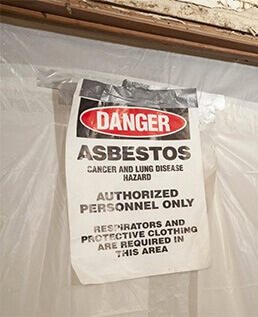Things To Do if You Think You have been Exposed to Asbestos
Posted in Asbestos Removal, on January 14, 2022
Anyone can be at risk of being exposed to asbestos. Regular asbestos testing in Toronto continues to uncover the mineral in many households today, as the fibres were a popular component in the construction of both commercial and residential buildings, especially those built between 1950 and 1980. To avoid the risk of exposure, asbestos abatement in Toronto is imperative, which should always be conducted by professionals, since addressing the issue independently can be quite dangerous.
Being exposed to asbestos fibres can result in a number of serious long-term health conditions such as mesothelioma, which is a type of cancer that can form in the lungs as a result of inhaling the mineral. The scary part about asbestos exposure is that the actual exposure event isn’t quite evident, as it can take up to 10 to 40 years for symptoms to appear.
At Canada’s Restoration Services, we offer careful inspections and 3rd party asbestos testing in Toronto. If asbestos is confirmed, our comprehensive and strategic asbestos containment procedure prevents friable fibres from going airborne to minimize the potential exposure. Following asbestos abatement in Toronto, we will also handle disposal strategically according to safety procedures and regional mandates.
If you’re concerned about the risk of asbestos exposure on your property, it’s important to assess your health before moving forward with full asbestos abatement in Toronto.
Identifying The Risk With Asbestos Testing in Toronto
.png) When asbestos fibres go airborne the risks associated with the mineral are incredibly high. Unfortunately, asbestos fibres are almost always easily disturbed, making the mineral more susceptible to inhalation, with minimal exposure potentially doing significant harm in the long term.
When asbestos fibres go airborne the risks associated with the mineral are incredibly high. Unfortunately, asbestos fibres are almost always easily disturbed, making the mineral more susceptible to inhalation, with minimal exposure potentially doing significant harm in the long term.
To effectively identify the risks of asbestos-containing materials (ACM), asbestos testing in Toronto is required. During this process, professionals at Canada’s Restoration Services will conduct a complete inspection, assess friability (likeliness to disintegrate), and provide samples to a third-party lab where the concentration and type of asbestos will be determined. Any ACM that is determined to have an asbestos concentration of 1% or higher 1% more than 1% asbestos must undergo asbestos removal. The risk is even higher if it happens to be blue or brown asbestos.
What to Wear Around Asbestos
Once asbestos has been confirmed and its threat level identified, be sure to wear PPE, such as approved respirator masks, to filter out airborne asbestos threats and mitigate the risk of inhaling the fibres. Asbestos fibres can latch onto your clothes, so it’s important to wear a special, disposable hazardous material suit when dealing with asbestos or change any clothes that may have been contaminated.
Visit Your Doctor
In addition to mesothelioma, other asbestos-related illnesses or conditions include lung cancer, asbestosis, cancer of the gastrointestinal tract, kidney or throat, and scarring of the lung lining. If you’re concerned that you’ve been exposed to asbestos, consult with your family doctor, as they can monitor for symptoms and help determine if you are at risk of developing any asbestos-related illnesses.
While limited exposure can be harmless, both short and long term, it’s those who are exposed to the mineral on a regular basis who are most at risk of developing an asbestos-related illness. People who develop such illnesses may experience shortness of breath, chest pains and a chronic cough. In some cases, you may cough up blood or see your weight deplete.
Dealing With Asbestos
Once an expert in asbestos abatement in Toronto at Canada’s Restoration Services has been consulted, your property is sealed off with a full containment perimeter during the removal process. Equipment gear is brought in to ensure that belongings are safe from any cross-contamination during the procedure. This all follows once samples have been provided and verified by a lab.







